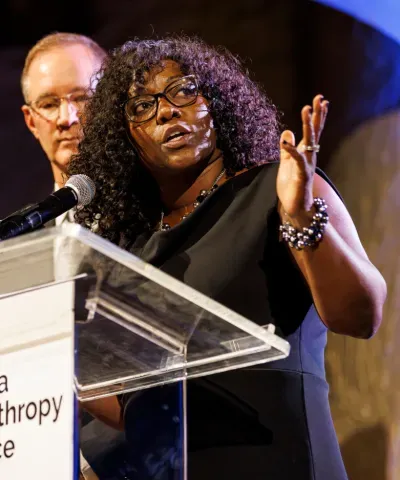The Power of Collective Impact
Neysa Meyer of The Putnam County Community Foundation reflects on lessons from Columbus, Indiana, showing how trust, shared purpose, and cross-sector collaboration can tackle complex challenges and create lasting community change.

16 June 2025
In today’s world, social challenges are more complex and deeply connected than ever before. Tackling issues like homelessness, early childhood education, public health, or economic inequality requires more than isolated efforts. It has become clear that no single organization, government agency, or philanthropic entity can solve these problems alone. Communities thrive when we shift from competition to collaboration, from individual efforts to collective impact.
As a member of the 2025 Mutz Philanthropic Leadership Institute, I recently witnessed the power of collective impact firsthand during a recent visit to Columbus, Indiana. There, our cohort met with various community leaders and learned about The Columbus Way, a unique approach to civic leadership that has evolved over decades. It's built on deep trust, cross-sector partnerships, and a long-term vision that puts community first. At the heart of it all is a powerful framework—not just as a concept, but as a lived, practiced strategy for aligning resources and people toward shared goals.
Why Now?
The urgency for collective impact has never been greater. Communities across Indiana and around the country are facing compounding challenges, such as education disparities, housing crises, and mental health emergencies. These are not single-issue problems. They are systemic and interconnected. Solutions require a united approach across public, private, and nonprofit sectors, and—most critically—the inclusion of voices which are often left behind.
We’ve seen what happens when collaboration works. In Columbus, we heard from various community leaders who spoke about The Columbus Way and various ways their community leaned into the Collective Impact framework designed by their community, for their community.
One notable initiative is the Community Education Coalition, established in 1997 through a partnership of community stakeholders, major businesses, and local educators. This long-term collaboration aims to align the region’s educational system with economic development and an enhanced quality of life. The coalition has focused on bridging education and employment, helping residents gain the skills and training needed to successfully enter the workforce. It has also expanded access to education by supporting the development of institutions and programs such as the Columbus Learning Center and the Advanced Manufacturing Center of Excellence. For Columbus, it wasn’t funding that made the difference—it was a shared purpose, data-informed action, and a commitment to work together across sectors.
Building a Culture of Collaboration
To foster collective impact, we must cultivate a culture of trust, humility, and inclusivity. Collaboration doesn’t mean losing autonomy—it means leveraging collective strengths.
This work is not easy. It requires time, patience, and a shared commitment to solving these complex issues. But the payoff is profound: healthier communities, more resilient economies, stronger schools, and a sense of shared ownership that can transform lives.
Communities flourish not because one person had the right answer, but because many people worked together to ask the right questions—and then answered them, together.

This article was written by a Mutz Philanthropic Leadership Institute class member. The institute is focused on building Indiana’s talent pipeline of senior professionals and board members within foundations and corporate giving programs.
explore the mutz institute



